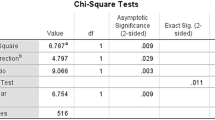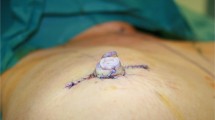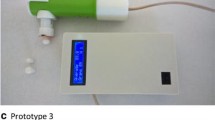Abstract
Adhesive agents are commonly used to fix nipple-areolar prostheses. However, these conventional methods can be technically difficult and time-consuming. We report a method that uses magnetic attachments and taping (MAT) to fix nipple-areolar prostheses. A silicone nipple-areolar prostheses and skin attachment units were embedded with magnets; the latter was fixed to the skin using surgical paper tape. We attached the prostheses to our own forearms to compare the MAT method and the conventional silicone adhesive method in terms of attachment time tensile and retention strength (tensile and shear strength). We also requested patients without a nipple-areolar complex to try the MAT method and assessed their levels of satisfaction. The MAT and conventional methods were tested for tensile and shear strength ten times each. The MAT method took a significantly shorter length of time to attach the prostheses compared with the conventional method. The MAT method resulted in a significantly stronger tensile strength compared to the conventional method, while the conventional method tended to be stronger in terms of shear strength. Four patients tried the MAT and reported higher levels of satisfaction for the former method than with the latter, although the level of satisfaction varied widely from one patient to another. The MAT method was found to be simpler to use and provides better retention strength compared with the conventional method. The findings suggest that the MAT method could potentially be a viable option to fix nipple-areolar prostheses.
Level of evidence: Level IV, Therapeutic





Similar content being viewed by others
Data Availability
The datasets generated during and/or analysed during the current study are available from the corresponding author on reasonable request.
References
Raghu KM, Gururaju CR, Sundaresh KJ, Mallikarjuna R (2013) Aesthetic finger prosthesis with silicone biomaterial. BMJ Case Rep 2013:bcr2013010385. https://doi.org/10.1136/bcr-2013-010385
Chen PH, Seidenfaden JC, Kase MT, Sooudi I (2021) Fabricating a partial nasal prosthesis with a custom nasal dilator design. J Prosthet Dent 126:447–451. https://doi.org/10.1016/j.prosdent.2020.05.029
Nomura T, Sato J, Matsuura M, Kawaguchi K, Sekiguchi R, Horie A, Seto K (2013) Lightweight acrylic resin facial prosthesis for maxillofacial defects: a fabrication and retention method. J Prosthet Dent 110:326–330. https://doi.org/10.1016/S0022-3913(13)60384-4
Nuseir A, Hatamleh MM, Alnazzawi A, Al-Rabab’ah M, Kamel B, Jaradat E, Alnazzawi Ahmad, Al-Rabab’ah M, Kamel B, Jaradat E (2019) Direct 3D printing of flexible nasal prosthesis: optimized digital workflow from scan to fit. J Prosthodont 28:10–14. https://doi.org/10.1111/jopr.13001
Sophie Yi JYS, Dierks EJ, Over LM, Hauck MJ (2012) Prosthetic reconstruction of the orbit/globe. Oral Maxillofac Surg Clin North Am 24:697–712. https://doi.org/10.1016/j.coms.2012.07.004
Nanda A, Jain V, Kumar R, Kabra K (2011) Implant-supported auricular prosthesis. Indian J Dent Res 22:152–156. https://doi.org/10.4103/0970-9290.79983
Cobein MV, Coto NP, Crivello Junior O, Lemos JBD, Vieira LM, Pimentel ML, Byrne HJ, Dias RB (2017) Retention systems for extraoral maxillofacial prosthetic implants: a critical review. Br J Oral Maxillofac Surg 55:763–769. https://doi.org/10.1016/j.bjoms.2017.04.012
Sainsbury R, Walker VA, Smith PM (1991) An improved nipple prosthesis. Ann R Coll Surg Engl 73:67–69
Janes S (2005) Custom-made nipple prosthesis: a long-term satisfaction survey. J Cancer Res Ther 1:111–113. https://doi.org/10.4103/0973-1482.16712
Rajasekaran R, Chander NG, Reddy JR, Balasubramanium M (2022) Estimation of differences and reapplication effect of peel bond strength between silicone-based and water-based adhesives. J Prosthet Dent. https://doi.org/10.1016/j.prosdent.2022.05.024
Kiat-amnuay S, Waters PJ, Roberts D, Gettleman L (2008) Adhesive retention of silicone and chlorinated polyethylene for maxillofacial prostheses. J Prosthet Dent 99:483–488. https://doi.org/10.1016/S0022-3913(08)60113-4
Sisti A (2020) Nipple-areola complex reconstruction. Medicina (Kaunas) 56:296. https://doi.org/10.3390/medicina56060296
Gougoutas AJ, Said HK, Um G, Chapin A, Mathes DW (2018) Nipple-areola complex reconstruction. Plast Reconstr Surg 141:404e–416e. https://doi.org/10.1097/PRS.0000000000004166
Polyzois GL (1994) Bond strength of double-sided adhesive tapes used for facial prostheses. Spec Care Dentist 14:26–29. https://doi.org/10.1111/j.1754-4505.1994.tb01092.x
Roth J, Albrecht V, Nitschke M, Bellmann C, Simon F, Zschoche S, Michel S, Luhmann C, Grundke K, Voit B (2008) Surface functionalization of silicone rubber for permanent adhesion improvement. Langmuir 24:12603–12611. https://doi.org/10.1021/la801970s
Kim SM (2017) Magnet-retained orbital prosthesis using a dental implant. J Craniofac Surg 28:e151–e152. https://doi.org/10.1097/SCS.0000000000003336
Kim SM, Cho YJ, Eo MY, Kim JS, Lee SK (2018) Silicone facial prosthesis: a preliminary report on silicone adhesion to magnet. J Craniofac Surg 29:e6–e8. https://doi.org/10.1097/SCS.0000000000003986
Buzayan MM (2014) Prosthetic management of mid-facial defect with magnet-retained silicone prosthesis. Prosthet Orthot Int 38:62–67. https://doi.org/10.1177/0309364613484052
Visser A, Noorda WD, Linde A, Raghoebar GM, Vissink A (2020) Bar-clip versus magnet-retained auricular prostheses: a prospective clinical study with a 3-year follow-up. J Prosthet Dent 124:240–247. https://doi.org/10.1016/j.prosdent.2019.05.033
Smith SM, Zirwas MJ (2015) Nonallergic reactions to medical tapes. Dermatitis 26:38–43. https://doi.org/10.1097/DER.0000000000000098
Grove GL, Zerweck CR, Houser TP, Smith GE, Koski NI (2013) A randomized and controlled comparison of gentleness of 2 medical adhesive tapes in healthy human subjects. J Wound Ostomy Continence Nurs 40:51–59. https://doi.org/10.1097/WON.0b013e318276f2a4
Benninga MA, van der Steeg AFW, Marsman HA, Rauws EA (2019) Perforation due to ingestion of multiple magnet beads. J Pediatr Gastroenterol Nutr 68:e34. https://doi.org/10.1097/MPG.0000000000001807
Conduit C, Cunliffe T, Beggs S, Ee M, Fenton E, Jones N (2013) Multiple magnet ingestion in children: near-fatal attractions. J Paediatr Child Health 49:505–506. https://doi.org/10.1111/jpc.12231
Acknowledgements
We want to thank Ulatus for English language editing.
Funding
This study was supported by a Grant-in-Aid for Scientific Research in 2020 (JSPS KAKENHI Grant Number JP 20K18565).
Author information
Authors and Affiliations
Contributions
Shogo Kasai and Emi Makino conceived and designed the analysis. Shogo Kasai did all the rest of the process. All authors reviewed the manuscript draft and revised it critically on intellectual content. All authors approved the final version of the manuscript to be published.
Corresponding author
Ethics declarations
Ethics approval
This study was approved by the Medical Research Ethics Review Committee for University of the Ryukyus (approval number 1741). All procedures performed in studies involving human participants were in accordance with the ethical standards of the institutional and/or national research committee and with the 1964 Helsinki declaration and its later amendments or comparable ethical standards.
Consent to participate
Before the study was initiated, written consent was obtained from patients after they received a written explanation of the study.
Consent for publication
Written informed consent was obtained from all patients in the outpatient department after surgery for publication of case details and accompanying images.
Conflict of interest
Shogo Kasai and Emi Makino declare no conflict of interest.
Additional information
Publisher's note
Springer Nature remains neutral with regard to jurisdictional claims in published maps and institutional affiliations.
Supplementary information
Below is the link to the electronic supplementary material.
Supplementary file1 (MP4 24630 KB)
Rights and permissions
Springer Nature or its licensor (e.g. a society or other partner) holds exclusive rights to this article under a publishing agreement with the author(s) or other rightsholder(s); author self-archiving of the accepted manuscript version of this article is solely governed by the terms of such publishing agreement and applicable law.
About this article
Cite this article
Kasai, S., Makino, E. Magnetic attachments and taping method for nipple-areolar prostheses retention: development of a method and case series. Eur J Plast Surg 46, 441–447 (2023). https://doi.org/10.1007/s00238-022-02038-w
Received:
Accepted:
Published:
Issue Date:
DOI: https://doi.org/10.1007/s00238-022-02038-w




